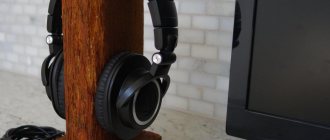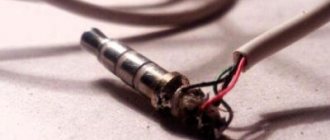Now almost every person has a gadget from which they can listen to music through headphones at work, in transport, and while walking. It could be a USB player or a phone, tablet or laptop. And many people listen to music at home, wearing headphones, so as not to disturb neighbors or family members.
Naturally, every music lover in his life has encountered the problem of torn ear pads for headphones. It is quite possible to repair them with your own hands if you know a few subtleties. Headphones come in different types: vacuum, with ear pads simply made of foam rubber or covered with leather. In this article we will look at different options for making ear pads for headphones with your own hands.
How to put ear pads on in-ear headphones
In-ear headphones come in a variety of varieties, but one thing is the same: all headphones of this type have a sound guide onto which the ear pads are placed.
There are many types of ear pads for in-ear headphones, but they all fit the same way.
The main rule is to put on the ear pad gradually; there is no need to try to pull it onto the sound guide over the entire cross-sectional area of the hole at once.
Any ear pad, be it silicone or foam, has a soft core.
For simplicity and convenience, I turned out the petals of the silicone ear pad before putting it on. This is not necessary, but depending on the softness of the material from which it is made, sometimes it needs to be done, otherwise it will be impossible to put the ear pad on the earphone. Lightly stretch one part of the core over the sound guide. Then, lightly pushing the remaining part, pull it to the end.
In some cases, when the properties of the materials from which the ear pads and the sound guide body are made allow, you can slightly turn it clockwise while tightening the ear pad, this will make it much more convenient and quick to put it on.
After installation, make sure that the ear pad core is completely in place, that it is not warped and that it is held securely. Then unfold the petals to their normal position.
In general, installing ear pads is not as difficult as removing some of them.
To sew ear pads with your own hands you will need:
To sew ear pads with your own hands you will need:
- To a barb of thin skin or leatherette
- Foam rubber that can be removed from the ear pads of other headphones. Unfortunately, a washing sponge will not work here; the foam rubber should allow air to pass freely. The best way to check is to try to blow through it
- Sewing supplies
- Artboard for creating patterns
- Compass marker, for marking cardboard
More information about the material used
When choosing a material, you should try to find it as thin as possible. In my opinion, sewing from leatherette is easier. In fact, finding it on sale is easier and cheaper. It is better to choose one that has a fabric base. You can also sew from velor - it all depends on your taste and the ability to get the material.
Both leather and leatherette are most often sold by the meter. The used leatherette was sold in rolls, about a meter wide. I bought 20 centimeters and even then there was about half of the material left. As for the price of the issue, such happiness cost about 2 dollars.
How to remove ear pads from in-ear headphones
Removing the ear pad from in-ear headphones without damaging it is not as easy as it might seem at first glance.
You need to remove it gradually, just as you put it on, first one part of the core, then the other. Look at the instructions above and do it in the reverse order, first unfold the petals, then slowly begin to pull one part of the ear cushion from the sound guide, then the other.
If you need to remove the foam cushion , try to grab it close to the base and slowly, with a slight twist, try to remove it. Usually this is successful and the ear cushion begins to come off; after a few turns it will completely come off the sound guide.
Remember: you cannot forcefully and persistently pull on the petals or the foam part, you need to do this carefully and carefully, otherwise there is a very high probability that you will damage or tear the ear pad.
How to install or remove ear pads from on-ear headphones
If on almost all in-ear headphones the ear pads are installed by pulling the silicone core onto the sound guide, then with full-size models there can be different options, starting with latches and ending with cunning fastening elements.
I will provide general information on how to change ear pads, but for each specific model I cannot do this, because... I don't have all the headphones in the world.
As an example of full-size headphones, I will use the Sennheiser HD 380 Pro model, and as an example of an on-ear model, I will use the Sony MDR-XB300.
In many cases, to carefully remove the ear pad, you will need a plastic spatula; if you don’t have one, a bank plastic card will do. You cannot use metal parts, because... they may damage the plastic or fabric of the headphones.
The ear cushion of the Sony MDR-XB300 headphones is secured with three latches. In order to remove it, you need to insert a plastic spatula or a bank card between the ear pad and the headphone body and pry it slightly. Do this carefully and gently, no need to make sudden or strong movements.
Remember, you should never use too much force; if the embouchure doesn't come off with moderate pressure, you're doing something wrong. Stop, look at the earphone again and think about whether you are doing everything correctly. If you use a lot of force, there is a very high probability of breaking the headphones.
Using a plastic card, I snapped off one latch; now you need to carefully pull the base of the ear pad and the remaining latches will easily detach.
As you can see, the ear pad is attached to the headphones using three latches.
To put the ear pad on the headphones, just attach it to the headphone, aligning the latches with the holes and press with moderate force. The latches click into place and the ear pad will fall into place.
Sound insulation: ear pads and cups
Any ear pads have only one common quality: they deteriorate over time, even if it’s not noticeable. Compare with new ones. Maybe it will turn out that after six months or a year they become softer, more comfortable, and the sound has become softer.
But more often the opposite situations happen: the material has become loose, the height has decreased, and the compositions take on a cotton-like shade.
The simplest modification to any over-ear (or any other) headphones is replacing the ear pads. There are no rules when changing - you have to search and experiment. Not only each manufacturer, but also each series (if it’s not like a huge audio holding company) can have its own properties.
Therefore, when replacing there are no rules. The main thing is that the material provides not only a comfortable fit, but also shades of sound: dense leather better reflects audio waves (adds volume), fine-pored dense filling works more effectively as a sound insulator and “increases” the volume of low frequencies.
Soft ear pads muffle sound. This is especially true when filled with fibrous materials. But they are much nicer for everyday wear.
By the way, no one bothers you to choose monitor ear pads for a compact model of headphones: either by fitting store-bought ones of a different size, or by adapting suitable ones from another manufacturer. In addition to convenience, Cheburashkas always sound “richer” - re-reflections of sound.
How to remove or install ear pads on full-size headphones
With over-ear headphones, you may have a variety of options for attaching the ear pads. We have already dealt with the latches, now I suggest you pay attention to a different type of ear pad mounting, which you can see in the example of the Sennheiser HD 380 Pro headphones.
The ear pad is attached to the headphones using a special plastic ring, which is inserted into the ear pad from the inside. In the photo you see the ear pad with the ring removed. I took it out on purpose so that you could understand more clearly how the mechanism works.
On the headphone body there are guides for installing the ring, and there are small latches on the guides. They are small, but you can see them if you look closely at the first photo of the Sennheiser HD 380 Pro.
In order to remove such an ear pad, just take it by the base, feel the plastic ring and slightly move it towards the outside and pull it towards you . The nearest latch will come away, so you can pull the ear pad off the adjacent latch and remove it entirely.
The ring holds onto the earphone tightly only if all the latches are latched. Once you release the ear pad with just one latch, it can be removed from the earphone quite easily.
To install an ear pad with a similar mount on a headphone, just attach it to the guide on the headphone body and, making sure that it matches, begin to push the ear pad to click the latches. This should be done by moving your fingers in a circle. After going through the entire ear pad several times, all the latches will work and the ear pad will hold tightly to the earphone.
You can check that everything is in order very simply - walk around the entire circumference of the ear pad, slightly pulling it away from the earphone. In a normal case, it should not move anywhere and there should be no gap between the ear pad and the headphones. If the base of the ear pad moves slightly away from the earphone when pulled back, then the nearest latch did not work and you need to push the ear pad to snap it into place.
Epilogue
Typically, we consider headphones solely as a means of playing music and focus on sound quality. The purpose of this article is to show headphones from a different perspective and suggest choosing them not only as “speakers for the ears,” but also as a personal accessory. You don’t buy a jacket three sizes larger or smaller simply because you like the cut. And you are unlikely to be ready to wear beautiful shoes that are a size smaller, pinching and pressing on all sides. So you should be just as demanding when it comes to headphones. Moreover, the correct fit of the headphones automatically guarantees better noise insulation and better sound. Therefore, the whole essence of the article can be summarized in one phrase: to find the ideal headphones, you need to constantly try, try on, apply and experience everything for yourself. No other way. Our task was to make your choice more informed.
stereo.ru
How to put ear pads on in-ear headphones
In-ear headphones come in a variety of varieties, but one thing is the same: all headphones of this type have a sound guide onto which the ear pads are placed.
There are many types of ear pads for in-ear headphones, but they all fit the same way.
The main rule is to put on the ear pad gradually; there is no need to try to pull it onto the sound guide over the entire cross-sectional area of the hole at once. Any ear pad, be it silicone or foam, has a soft core.
For simplicity and convenience, I turned out the petals of the silicone ear pad before putting it on. This is not necessary, but depending on the softness of the material from which it is made, sometimes it needs to be done, otherwise it will be impossible to put the ear pad on the earphone. Lightly stretch one part of the core over the sound guide. Then, lightly pushing the remaining part, pull it to the end.
In some cases, when the properties of the materials from which the ear pads and the sound guide body are made allow, you can slightly turn it clockwise while tightening the ear pad, this will make it much more convenient and quick to put it on.
After installation, make sure that the ear pad core is completely in place, that it is not warped and that it is held securely. Then unfold the petals to their normal position.
In general, installing ear pads is not as difficult as removing some of them.
DIY headphones: step-by-step instructions
To know how to make your own headphones, you can use the following assembly instructions:
- Choose a plug that matches all the requirements of the connector for the sound source (smartphone or laptop). At the moment, we can note one of the most popular types - miniJack. The size of this output can be 3.5 or 6.3 mm. 6.3 is most often used in stationary home devices, 3.5 in mobile equipment.
- Then disconnect the plug. Then lay the wire into the groove, which must have 4 cores.
- Then locate the support on the plug that is used to secure the wire. Such a rack must have a hole. Solder 2 wires from the cable to it. Attach the remaining 2 to two small terminals. Before doing this, place thin insulating tubes on the wires.
- Then wrap the wire with insulating tape and fix the wrapped part in the rack.
- Install the plug cover and use a simple ohmmeter to check the plug for possible shorts.
- Choose 2 small speakers that are the same size. The resistance of one must be no more than 8 ohms. Insert the speakers into special housings. To perform this operation, you can use small plastic barrels. Then connect one resistor in parallel with a resistance of no more than 30 Ohms.
- Afterwards you need to take care of the headband. It can be made from an unnecessary iron ruler. Install and secure the emitters on the headband. This step can be accomplished in different ways, for example, you can use nuts and bolts. The most important thing to note is that sharp protruding parts can cause injury in the future, so it is advisable to avoid these elements.
- Next, connect 2 wires to the emitters. Attach the first of them to the plug stand, and the other to one of the terminals.
If all workable elements have been selected, then the self-made headphones will be no worse in quality than the factory headset.
How to remove ear pads from in-ear headphones
Removing the ear pad from in-ear headphones without damaging it is not as easy as it might seem at first glance.
You need to remove it gradually, just as you put it on, first one part of the core, then the other. Look at the instructions above and do it in the reverse order, first unfold the petals, then slowly begin to pull one part of the ear cushion from the sound guide, then the other.
If you need to remove the foam cushion , try to grab it close to the base and slowly, with a slight twist, try to remove it. Usually this is successful and the ear cushion begins to come off; after a few turns it will completely come off the sound guide.
Remember: you cannot forcefully and persistently pull on the petals or the foam part, you need to do this carefully and carefully, otherwise there is a very high probability that you will damage or tear the ear pad.
How to install or remove ear pads from on-ear headphones
If on almost all in-ear headphones the ear pads are installed by pulling the silicone core onto the sound guide, then with full-size models there can be different options, starting with latches and ending with cunning fastening elements.
I will provide general information on how to change ear pads, but for each specific model I cannot do this, because... I don't have all the headphones in the world.
As an example of full-size headphones, I will use the Sennheiser HD 380 Pro model, and as an example of an on-ear model, I will use the Sony MDR-XB300.
In many cases, to carefully remove the ear pad, you will need a plastic spatula; if you don’t have one, a bank plastic card will do. You cannot use metal parts, because... they may damage the plastic or fabric of the headphones.
The ear cushion of the Sony MDR-XB300 headphones is secured with three latches. In order to remove it, you need to insert a plastic spatula or a bank card between the ear pad and the headphone body and pry it slightly. Do this carefully and gently, no need to make sudden or strong movements.
Remember, you should never use too much force; if the embouchure doesn't come off with moderate pressure, you're doing something wrong. Stop, look at the earphone again and think about whether you are doing everything correctly. If you use a lot of force, there is a very high probability of breaking the headphones.
Using a plastic card, I snapped off one latch; now you need to carefully pull the base of the ear pad and the remaining latches will easily detach.
As you can see, the ear pad is attached to the headphones using three latches.
To put the ear pad on the headphones, just attach it to the headphone, aligning the latches with the holes and press with moderate force. The latches click into place and the ear pad will fall into place.
A little theory
Any speaker system consists of standard components:
- signal source,
- sound emitter,
- sound amplifying elements,
- the volume over which sound travels
- the external environment in which the speaker system is located.
Each element contributes.
And it doesn’t matter at all what plays the role of this or that element in the type of acoustic system (AS) under consideration. For example, for closed (monitor) headphones, the main role is played by the closed volume of air between the auricle and the speaker, since the external environment is a small volume of air behind the speaker, closed by a cup.
In this case, it is not customary to take the external environment as an additional factor; it only works for some development masters. Even if it is connected to the volume of air inside the earphone by bass reflex holes.
Open headphones almost completely copy the operation of desktop speaker systems, differing only in the distance to the listener and the absence of sound reflections from the walls. But there are reflections from and in the auricle, often stronger than in tabletop or floor-standing speakers.
How to remove or install ear pads on full-size headphones
With over-ear headphones, you may have a variety of options for attaching the ear pads. We have already dealt with the latches, now I suggest you pay attention to a different type of ear pad mounting, which you can see in the example of the Sennheiser HD 380 Pro headphones.
The ear pad is attached to the headphones using a special plastic ring, which is inserted into the ear pad from the inside. In the photo you see the ear pad with the ring removed. I took it out on purpose so that you could understand more clearly how the mechanism works.
On the headphone body there are guides for installing the ring, and there are small latches on the guides. They are small, but you can see them if you look closely at the first photo of the Sennheiser HD 380 Pro.
In order to remove such an ear pad, just take it by the base, feel the plastic ring and slightly move it towards the outside and pull it towards you . The nearest latch will come away, so you can pull the ear pad off the adjacent latch and remove it entirely.
The ring holds onto the earphone tightly only if all the latches are latched. Once you release the ear pad with just one latch, it can be removed from the earphone quite easily.
To install an ear pad with a similar mount on a headphone, just attach it to the guide on the headphone body and, making sure that it matches, begin to push the ear pad to click the latches. This should be done by moving your fingers in a circle. After going through the entire ear pad several times, all the latches will work and the ear pad will hold tightly to the earphone.
You can check that everything is in order very simply - walk around the entire circumference of the ear pad, slightly pulling it away from the earphone. In a normal case, it should not move anywhere and there should be no gap between the ear pad and the headphones. If the base of the ear pad moves slightly away from the earphone when pulled back, then the nearest latch did not work and you need to push the ear pad to snap it into place.
This is the story of how headphones got the right to a second life.
There were old headphones that I loved very much and they made me happy. But the ear pads of the headphones began to deteriorate. They started falling apart :(
After thinking a little, I decided that I wanted to try to restore them.
To do this, I went to the nearest store to buy materials. For a long time I chose the material so that it would be pleasant for the ears and serve well. My choice fell on suede.
First, I removed the existing ear pads from the headphones.
Then I took measurements for my future ear pads and prepared rings like these. The blanks should be made a little larger, taking into account the folds of the fabric. And cut out rings of fabric.
And I started sewing ear pads for the headphones. To begin, I sewed the cut out large circles of fabric along the inner (smaller) diameter. I place them with their right sides facing each other, insert the thread into the needle and walk in a circle with small stitches at a distance of 2-3 mm from the edge. Next, I turn the sewn workpiece inside out and check that I stitched it well everywhere.
Then I lay down the foam. Before stitching along the outside edge, I cut out another ring. The outer diameter of the ring is equal to the diameter of the rings in which the foam rubber was placed. The inner diameter was made smaller. This ring is necessary to be able to put the covered ear pads on the headphones. Then I placed the rings together and sewed them together. I did it manually.
I sewed two rings and put them on the headphones
This is how the headphones turned out.
They got a second life and will continue to please me :)
Possible duplicates found
They are not always at the right price. When the price of headphones is 1500 rubles, on Ali ear pads can cost 600 rubles. What's the point of taking them then?
Or you'll find hell.
I have a 2012 headset, and it is a modification of an older model.
The ear pads are of a non-standard shape, so you can’t find them on Ali.
It’s good that under the peeling leatherette there is normal black fabric.
But the wire would need to be replaced, but I’m not sure it would be possible to do it properly, because I’m worse at soldering than a monkey with Parkinson’s.
This one has been alive for two years, has not hardened or torn, all the others have dulled and cracked after six months due to constant contact with the body.
Oo Ugreen do normal things. Thank you )
I came up with a good idea for a donor - a USB cable.
I am especially inclined towards a cable with a fabric braid - so that it does not bend or become dull over time.
All I have to do is either buy a cable, a soldering iron and hope that I can fix it, or look for someone who can help with it.
In my opinion, the wires from the chargers are too flimsy.
But in my case they will not work.
My wire from the remote control to the headset broke. It is just about half a meter in length. In addition, there are not enough cores in the wire from the charger. So a USB cable is just right for me.
What's the point of restoring headphones for 1500 rubles?
1500 is a normal amount that you don’t want to give again without special need.
And, of course, we won’t count our time. Gasoline to go to the store for materials too. You can darn your socks and sew up your panties with the same success. This is not a rational approach. Even for a 25k salary per month, mending a headphone part that costs 300 rubles is not rational, unless this is your hobby and you relax like that.
Pah) Of course, any fool, I suppose you drive a Bentley, you don’t need to buy a lot of intelligence)
Are you going to say that you have to work and earn more and better money in order to buy new headphones or spare parts, instead of repairing it yourself and wasting time on it?) Well, that’s right, why the hell do you do anything with your own hands if you can buy everything) By -I think this is called consumerism)
because you come to the store, and the same ones that you bought three years ago for 1500 cost 3000, and you’re like “fuck it, you saw that” and move on
Well then they cost not 1500, but 3000 and you shouldn’t mind paying 300 rubles for the pads)
No, spend the evening fucking and sewing. There's nothing else to do. Although I have to admit, I'm having an even dumber time just talking to you now.
when my headphones started to fall off, I looked up how much new ear pads cost, it turned out to be around 800 rubles (the headphones cost 2k), well, I just picked out everything that had fallen off, there was fabric left
About 10 years ago I bought headphones for about $100. I didn’t pay attention to the ear pads, the sound was more important. So, initially there were ear pads made of some kind of velvet or something like a terry towel. And they don’t mind over the years, unlike others with materials similar to dermontin.
And this photo was very reminiscent of those headphones.
Ear pads are usually made from velor. I like genuine leather)))
And give me three-layer toilet paper. and softer headphones. only hardcore.
The right one stopped playing on my bluetooth drops. Will you re-solder it for me?
Come on, bluetooth headphones also die starting from the right?
I didn't notice this pattern either. until I started checking all my old headphones.
There will be almost no low frequencies now
Ah... suede. Well, she should probably be fine. For some reason it seemed to me that you were just doing it with a cloth on top of the foam.
I myself am constantly puzzled by this problem. My headphones often wear out. I keep dreaming of finding thin real leather somewhere for sale.











